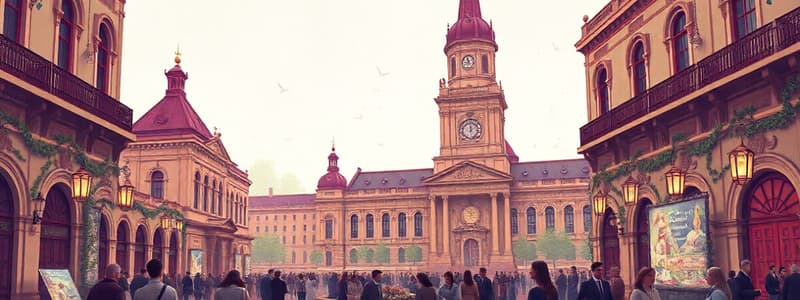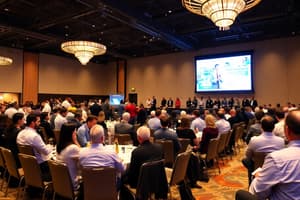Podcast
Questions and Answers
MICE stands for Meetings, ______, Conferences, and Exhibitions.
MICE stands for Meetings, ______, Conferences, and Exhibitions.
Incentives
MICE tourism is primarily focused on ______ travelers who attend organized events.
MICE tourism is primarily focused on ______ travelers who attend organized events.
business
The ______ Fair in China is one of the largest exhibitions in the world.
The ______ Fair in China is one of the largest exhibitions in the world.
Canton
A ______ company in the Philippines might host a strategy meeting at the PICC.
A ______ company in the Philippines might host a strategy meeting at the PICC.
Incentives are also known as "______ Programs" or "Reward Programs".
Incentives are also known as "______ Programs" or "Reward Programs".
A multinational corporation might reward top-performing sales teams with an all-expenses-paid trip to ______.
A multinational corporation might reward top-performing sales teams with an all-expenses-paid trip to ______.
Unlike meetings, conferences typically have a ______ number of attendees.
Unlike meetings, conferences typically have a ______ number of attendees.
The Philippine Travel Exchange (PHITEX) showcases the country's MICE capabilities by hosting ______ delegates.
The Philippine Travel Exchange (PHITEX) showcases the country's MICE capabilities by hosting ______ delegates.
Conferences are also referred to as "______" and are typically held over several days.
Conferences are also referred to as "______" and are typically held over several days.
The main purpose of a conference is to share ______, find solutions to challenges, and network.
The main purpose of a conference is to share ______, find solutions to challenges, and network.
Common activities in conferences include workshops, ______, presentations, and speeches.
Common activities in conferences include workshops, ______, presentations, and speeches.
Conferences typically involve key members of an organization, ______ speakers, and the public.
Conferences typically involve key members of an organization, ______ speakers, and the public.
The ASEAN Tourism Forum, held in various member countries such as the Philippines, brings together ______ professionals.
The ASEAN Tourism Forum, held in various member countries such as the Philippines, brings together ______ professionals.
Exhibitions, also known as ______ or expo, showcase products, services, or ideas to a targeted audience.
Exhibitions, also known as ______ or expo, showcase products, services, or ideas to a targeted audience.
Through exhibitions, companies can highlight their goods, ______, and inventions.
Through exhibitions, companies can highlight their goods, ______, and inventions.
The Travel Madness Expo in Manila gathers industry ______ and travelers.
The Travel Madness Expo in Manila gathers industry ______ and travelers.
The MICE industry consists of four major components: planners, host facilities, ______, and exhibitors.
The MICE industry consists of four major components: planners, host facilities, ______, and exhibitors.
Meeting planners can be categorized as corporate meeting planners, association meeting planners, and ______ meeting planners.
Meeting planners can be categorized as corporate meeting planners, association meeting planners, and ______ meeting planners.
Host facilities provide ______, meeting rooms, food and beverage, and other services for groups attending meetings.
Host facilities provide ______, meeting rooms, food and beverage, and other services for groups attending meetings.
Services within the MICE industry encompass organizations that provide support for meetings, conventions, and exhibitions, and are considered a segment of the ______ and hospitality industry.
Services within the MICE industry encompass organizations that provide support for meetings, conventions, and exhibitions, and are considered a segment of the ______ and hospitality industry.
Exhibitors, also referred to as advertising directors, communication directors, or directors of marketing, aim to introduce their ______ to interested clients.
Exhibitors, also referred to as advertising directors, communication directors, or directors of marketing, aim to introduce their ______ to interested clients.
Exhibitors financially contribute to the MICE industry by providing much of the ______ needed for events.
Exhibitors financially contribute to the MICE industry by providing much of the ______ needed for events.
MICE significantly contributes to the economy by generating revenue for hotels, ______, and local businesses.
MICE significantly contributes to the economy by generating revenue for hotels, ______, and local businesses.
DMOs promote ______ to attract MICE events.
DMOs promote ______ to attract MICE events.
DMOs highlight unique selling points such as ______, accessibility, and cultural appeal.
DMOs highlight unique selling points such as ______, accessibility, and cultural appeal.
One of the responsibilities of DMOs is marketing the destination to ______ and organizations.
One of the responsibilities of DMOs is marketing the destination to ______ and organizations.
DMOs support ______ and event planning by connecting stakeholders.
DMOs support ______ and event planning by connecting stakeholders.
Effective relationships among stakeholders are the ______ of successful MICE events.
Effective relationships among stakeholders are the ______ of successful MICE events.
Planner-Supplier Relationships involve planners relying on suppliers to provide ______ services.
Planner-Supplier Relationships involve planners relying on suppliers to provide ______ services.
Planner-DMO Partnerships involve DMOs assisting planners in promoting events and securing ______ at the destination.
Planner-DMO Partnerships involve DMOs assisting planners in promoting events and securing ______ at the destination.
Supplier-DMO Coordination entails suppliers working closely with DMOs to align their offerings with ______ strategies.
Supplier-DMO Coordination entails suppliers working closely with DMOs to align their offerings with ______ strategies.
MICE events play a ______ role in boosting local economies.
MICE events play a ______ role in boosting local economies.
Hosting MICE events enhances ______ opportunities and brings revenue to destinations.
Hosting MICE events enhances ______ opportunities and brings revenue to destinations.
Participants of MICE events spend on ______, dining, transportation, and leisure activities.
Participants of MICE events spend on ______, dining, transportation, and leisure activities.
MICE events create opportunities for knowledge ______, cross-cultural understanding, and professional networking.
MICE events create opportunities for knowledge ______, cross-cultural understanding, and professional networking.
Hosting international events allows destinations to highlight their ______ heritage through performances, cuisine, and traditions.
Hosting international events allows destinations to highlight their ______ heritage through performances, cuisine, and traditions.
Quantifying the impacts of MICE Events is complex due to their ______ nature.
Quantifying the impacts of MICE Events is complex due to their ______ nature.
The ______ impact of MICE Events is often overlooked in evaluations.
The ______ impact of MICE Events is often overlooked in evaluations.
The first step in risk management is risk ______ – Recognize potential risks.
The first step in risk management is risk ______ – Recognize potential risks.
In risk assessment, risks are classified into categories of high, medium, and ______ impact.
In risk assessment, risks are classified into categories of high, medium, and ______ impact.
A good communication plan ensures all ______ are aware of the risks and contingency plans.
A good communication plan ensures all ______ are aware of the risks and contingency plans.
Backup resources may include alternative suppliers or ______.
Backup resources may include alternative suppliers or ______.
Defining objectives helps to establish the ______ of the event.
Defining objectives helps to establish the ______ of the event.
Project management tools like Trello use boards and ______ for task management.
Project management tools like Trello use boards and ______ for task management.
In concept development, identifying the target ______ is important to tailor the event experience.
In concept development, identifying the target ______ is important to tailor the event experience.
The process of creating a timeline involves listing all activities and setting ______ for each task.
The process of creating a timeline involves listing all activities and setting ______ for each task.
The ______ and location should align with the event concept and audience needs.
The ______ and location should align with the event concept and audience needs.
Continuous evaluation of risks includes monitoring and ______ plans as needed.
Continuous evaluation of risks includes monitoring and ______ plans as needed.
Flashcards
MICE
MICE
An acronym for Meetings, Incentives, Conferences, and Exhibitions; a segment of business tourism.
Business-Oriented Tourism
Business-Oriented Tourism
A tourism segment focused on business travelers attending organized events for productivity and networking.
Customization and Planning
Customization and Planning
Tailoring events to achieve specific organizational goals, like product launches or teamwork.
Economic Contribution
Economic Contribution
Signup and view all the flashcards
Meetings
Meetings
Signup and view all the flashcards
Incentives
Incentives
Signup and view all the flashcards
Conferences
Conferences
Signup and view all the flashcards
Canton Fair
Canton Fair
Signup and view all the flashcards
Risk Identification
Risk Identification
Signup and view all the flashcards
Risk Assessment
Risk Assessment
Signup and view all the flashcards
Risk Mitigation
Risk Mitigation
Signup and view all the flashcards
Communication Plan
Communication Plan
Signup and view all the flashcards
Monitoring and Reviewing
Monitoring and Reviewing
Signup and view all the flashcards
Contingency Planning
Contingency Planning
Signup and view all the flashcards
Concept Development
Concept Development
Signup and view all the flashcards
Timeline in Event Planning
Timeline in Event Planning
Signup and view all the flashcards
Project Management Tools
Project Management Tools
Signup and view all the flashcards
Backup Resources
Backup Resources
Signup and view all the flashcards
Exhibitions
Exhibitions
Signup and view all the flashcards
Planners
Planners
Signup and view all the flashcards
Host Facilities
Host Facilities
Signup and view all the flashcards
Services in MICE
Services in MICE
Signup and view all the flashcards
Exhibitors
Exhibitors
Signup and view all the flashcards
Economic Impact of MICE
Economic Impact of MICE
Signup and view all the flashcards
Boost Tourism Infrastructure
Boost Tourism Infrastructure
Signup and view all the flashcards
Cultural Exchange
Cultural Exchange
Signup and view all the flashcards
Employment Opportunities in MICE
Employment Opportunities in MICE
Signup and view all the flashcards
Sustainable Tourism Growth
Sustainable Tourism Growth
Signup and view all the flashcards
Event Concept Development
Event Concept Development
Signup and view all the flashcards
Budgeting in MICE
Budgeting in MICE
Signup and view all the flashcards
Venue Selection
Venue Selection
Signup and view all the flashcards
Destination Marketing Organizations (DMOs)
Destination Marketing Organizations (DMOs)
Signup and view all the flashcards
Key Responsibilities of DMOs
Key Responsibilities of DMOs
Signup and view all the flashcards
Stakeholder Relationships
Stakeholder Relationships
Signup and view all the flashcards
Planner-Supplier Relationships
Planner-Supplier Relationships
Signup and view all the flashcards
Planner-DMO Partnerships
Planner-DMO Partnerships
Signup and view all the flashcards
Supplier-DMO Coordination
Supplier-DMO Coordination
Signup and view all the flashcards
Building Strong Stakeholder Relationships
Building Strong Stakeholder Relationships
Signup and view all the flashcards
Cultural Differences in MICE
Cultural Differences in MICE
Signup and view all the flashcards
Direct Spending in MICE
Direct Spending in MICE
Signup and view all the flashcards
Job Creation from MICE
Job Creation from MICE
Signup and view all the flashcards
Cultural Exchange in MICE
Cultural Exchange in MICE
Signup and view all the flashcards
Networking Opportunities
Networking Opportunities
Signup and view all the flashcards
Risk Management
Risk Management
Signup and view all the flashcards
Challenges in Measuring MICE Impacts
Challenges in Measuring MICE Impacts
Signup and view all the flashcards
Study Notes
MICE Introduction
- MICE stands for Meetings, Incentives, Conferences, and Exhibitions
- Focuses on large-scale business events, involving planning, organizing, and hosting.
- Driven by professional networking, knowledge sharing, motivation, and business development.
- Differs from leisure tourism in its focus on productivity and professional interaction.
Key Concepts of MICE
- Business-Oriented Tourism: Primarily for business travelers at organized events. Examples include WTTC Summit in the Philippines and Canton Fair in China.
- Customization and Planning: Events tailored to specific organizational needs (product launches, team building, industry advancements).
- Economic Contribution: Boosts demand for hotels, restaurants, transportation, and local services, generating significant economic benefits.
Meetings, Incentives, Conferences, & Exhibitions (Definitions)
- Meetings: Formal gatherings for business, social, or religious purposes. Smaller scale.
- Incentives: Reward programs for partners, clients, or staff. Often involve corporate events or performances.
- Conferences: Larger-scale events (conventions), typically held over days. Aim to share insights, find solutions, and network. Involve key members, guest speakers, and sometimes the public.
- Exhibitions: Trade shows showcasing products, services, or ideas. Engage with stakeholders and potential customers.
Components of the MICE Industry
- Planners: Individuals/groups planning meetings, conventions, and exhibitions (corporate, association, independent).
- Host Facilities: Hotels, conference rooms, resorts, universities which provide lodging, rooms, F&B, and related services.
- Services: Support services for the meetings, conventions, and exhibitions (transportation, tour guides, entertainers).
- Exhibitor: Focus on introducing products, services, or ideas to interested, potential clients, customers, and partners.
Importance of MICE in Tourism and Hospitality
- Economic Impact: Generates revenue for hotels, transportation, and local businesses. Contributes to national GDP. Expected to lead the MICE destination in the Asia Pacific region by 2030.
- Boost Tourism Infrastructure: Drives destination improvements in hotels, convention centers, and transportation networks to attract events. Examples include Singapore's Marina Bay Sands and SMX Convention Center in the Philippines.
- Promotes Cultural Exchange: Allows destinations to showcase culture, fostering understanding & appreciation.
- Employment Opportunities: Creates jobs in event planning, hospitality, marketing, and logistics.
- Sustainable Tourism Growth: Promotes green meetings and eco-friendly venues to minimise environmental impact.
Overview of Stakeholders in MICE Industry
- Successful MICE events rely on collaboration across multiple stakeholders (planners, suppliers, DMOs).
Roles of Planners
- Event Concept Development
- Budgeting and Financial Planning
- Venue Selection
- Coordination (suppliers, speakers, clients)
- Risk Management
Roles of Suppliers
- Venue Providers (hotels/centers)
- Caterers
- Technology Providers (AV, apps)
- Transportation Services
Roles of DMOs (Destination Marketing Organizations)
- Marketing the destination to event planners.
- Supporting logistics and event planning.
- Advocating for tourism policies (to enhance MICE offerings).
- Showcasing cultural and natural attractions.
Key Stakeholder Relationship
- Effective relationships are the backbone of successful MICE events, ensuring events meet goals and deliver value.
Stakeholder Collaboration Models
- Planner-Supplier: Planners rely on high-quality supplier services.
- Planner-DMO: DMOs promote events and secure resources.
- Supplier-DMO: Suppliers align offerings with destination branding strategies.
Building Strong Stakeholder Relationships
- Communication, mutual goals, and adaptability.
Challenges in Stakeholder Relationships
- Cultural differences
- Resource allocation disputes
- Technology gaps
Economic and Cultural Impact of MICE Events
- Contribution to Local Economies: Stimulates demand for hospitality, transportation, retail, and tourism. Increases employment and destination revenue. Direct spending, job creation, infrastructure development, economic multiplier effect.
- Cultural Exchange and Networking: Fosters cross-cultural understanding and professional networking. Showcases local culture and traditions. Examples: Aliwan Fiesta in the Philippines, ASEAN Tourism Forum.
Challenges in Measuring MICE Impacts
- Environmental concerns (carbon emissions)
- Data collection issues
- Lack of standard metrics
- Attribution difficulties (isolating MICE impact from other factors)
Event Planning Fundamentals: Risk Management & Contingency Planning
- Risk Management: Identifying, assessing, and mitigating potential event threats.
- Contingency Planning: Preparing alternative solutions for risks.
- Risk Identification - Recognizing potential event-related issues.
- Risk Assessment: Assessing likelihood and impact of potential risks.
- Risk Mitigation: Developing proactive measures to reduce risks (reliable vendors, insurance).
- Communication: Ensuring stakeholders are aware of the plan.
- Monitoring: Evaluating the event and adapting contingency measures.
- Contingency Planning: Preparing alternative resources, delegating responsibilities, and testing plans.
Event Planning Fundamentals: Concept Development
- Defining objectives
- Identifying target audience
- Establishing a theme and format
- Choosing a venue
- Developing a budget
Event Planning Fundamentals: Timeline and Project Management Tools
- Creating a detailed timeline with deadlines for key event activities.
- Utilizing project management tools to streamline the event planning process (Trello, Asana, MS Project, Google Workspace).
Studying That Suits You
Use AI to generate personalized quizzes and flashcards to suit your learning preferences.



